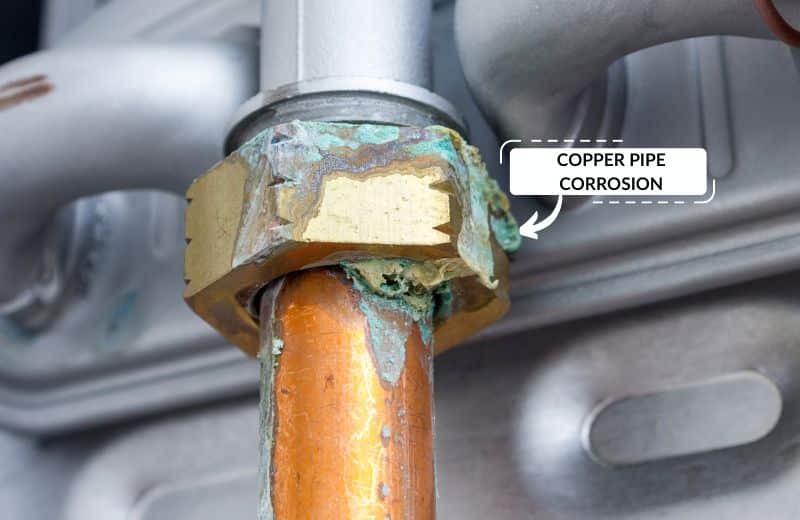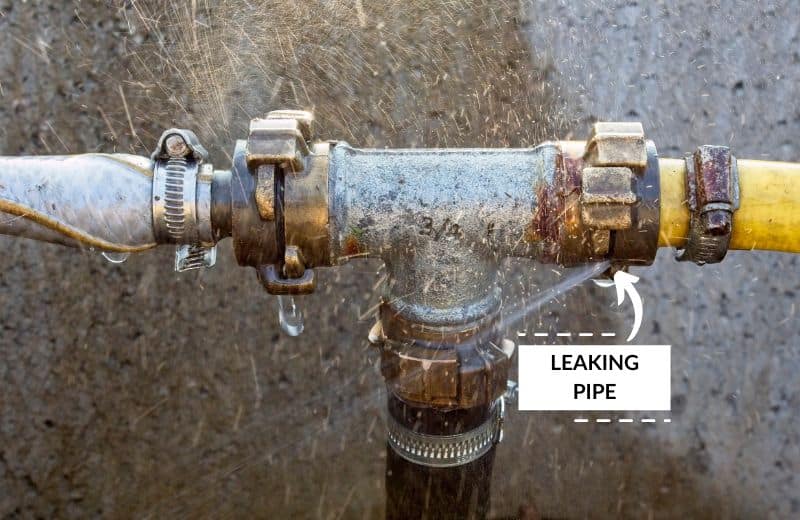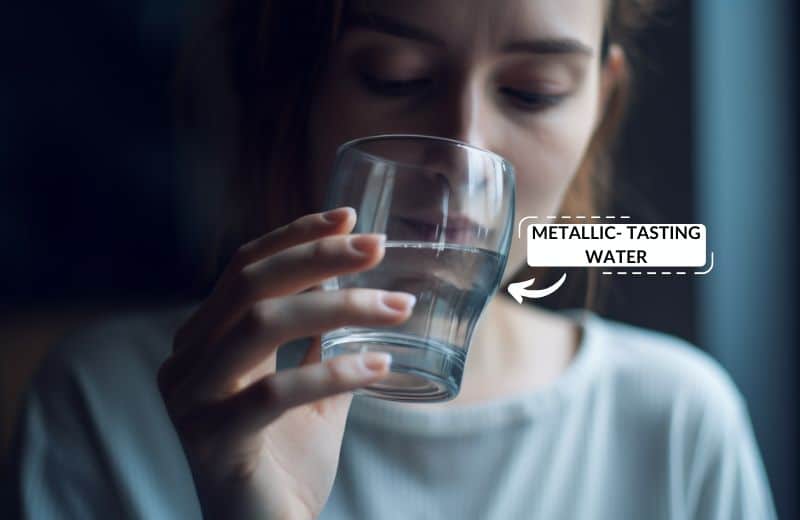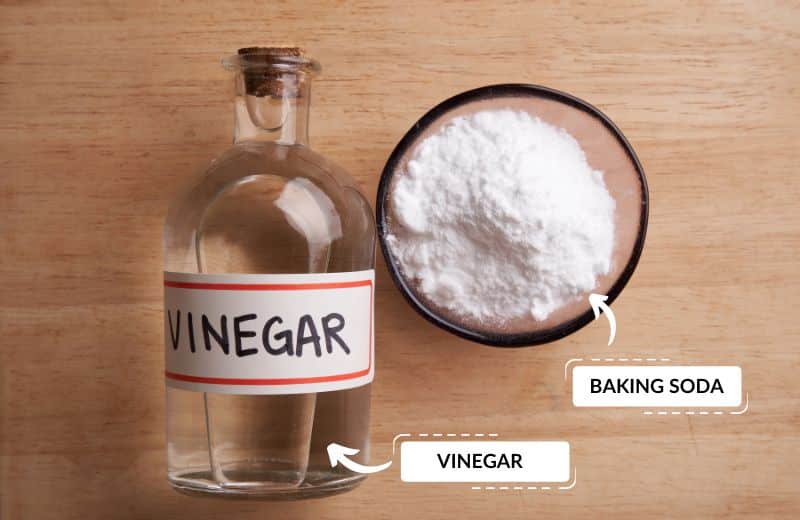If your copper pipes have started turning green, you likely have a corrosion issue.
Here, we’ve shared everything you need to know about copper pipe corrosion, including what causes it, its effects, and how to fix or resolve the issue.
📌 Key Takeaways:
- Copper pipe corrosion happens when the pipe is exposed to certain environmental conditions and leads to the formation of a green substance on the pipe surface.
- A few methods to remove green corrosion include applying a scrub made from white vinegar, salt, baking soda, and flour, and cleaning the pipe with acetone or an emery cloth.
- You can care for your copper pipes by getting them routinely inspected, installing a water filter to prevent further corrosion caused by your water quality, and insulating exposed pipes.
Table of Contents
- 🤔 What Is Copper Pipe Corrosion?
- 📋 What Causes Corrosion Of Copper Pipes?
- 🔎 Signs Of Copper Pipe Corrosion
- ⚠️ Is Copper Pipe Corrosion Dangerous?
- 📈 Potential Effects Of Corrosion In Your Copper Pipes
- 📤 How To Remove Green Corrosion From Copper Pipes
- 🔀 Should You Replace Corroded Copper Pipes?
- 🧰 How to Care For Your Copper Pipes
- 📑 Final Word – When To Hire A Plumber
🤔 What Is Copper Pipe Corrosion?
Copper pipe corrosion is when a copper pipe takes on a green color, often as a result of exposure to oxygen (green oxidation) or other water parameters.
The green compound formed as a result of copper corrosion is called patina.
Corrosion occurs when the metal in the piping begins to dissolve into the water. This can eventually result in tiny leaks or even a burst pipe.
The copper pipes in your entire plumbing system, including in water heating systems, fixtures, and appliances, are all at risk of the effects of green corrosion.

📋 What Causes Corrosion Of Copper Pipes?
Copper pipe corrosion is caused by a few different things:
- Certain water parameters, such as low TDS, high sediment levels, and a high dissolved oxygen concentration
- Incorrectly installed pipes
- High water flow rates
- Improper electrical grounding
Copper is durable, affordable, and lightweight, which is why it’s so commonly used in plumbing systems. However, copper is the most prone to corrosion of all water pipe materials.
It’s often not possible to determine the exact cause of your water pipe corrosion. We recommend testing your water and asking a plumber to inspect your pipes, but if the cause can’t be determined, that’s okay – you can still effectively remove the staining and prevent it from returning.
Related: How Salt Water Corrosion Affects Your Plumbing
🔎 Signs Of Copper Pipe Corrosion
The biggest sign of copper pipe corrosion is a color change. Copper pipes turn green when they corrode (their original color is orangey-red).
Other signs of corrosion in your pipes are:
- A sudden reduction in water pressure, caused by buildup inside the pipe or a pinhole leak
- Ceiling stains or soggy carpet, caused by a hidden leak
- Discoloration of your water
We’ve shared more detail about the things you may notice if you have corroded pipes in the “potential effects” section.

⚠️ Is Copper Pipe Corrosion Dangerous?
Green copper pipes themselves aren’t considered dangerous, but if your pipes are heavily corroded, they may have a couple of associated risks:
- A catastrophic leak due to structural damage caused by the wearing away of the pipe material
- Health effects from drinking high concentrations of copper in your water
Both of these risks are, thankfully, very unlikely to occur. However, if oxidation and corrosion go unnoticed and untreated for a very long time, there’s a potential for leaks and copper contamination of your water.
📈 Potential Effects Of Corrosion In Your Copper Pipes
Some of the potential effects of corrosion in your copper pipes are:
Excess Copper In Water
As your water flows through corroding copper piping, it’ll pick up some of the metals, increasing its copper concentration. The EPA MCLG for copper is 1.3 mg/L, but your water may contain more copper than this if your pipes are corroding.
Related: What to know about the EPA lead and copper rule
Metallic Water Taste & Smell
If your water is leaching heavy metals from your pipes, it’ll take on a metallic taste and smell. Copper has a bitter taste that you’ll probably find unpleasant to drink.

Bluish-Green Stains
Water that’s rich in copper may also stain your other surfaces, such as the drains in your sinks and bathtubs.
Leaks & Pipe Failure
If left unresolved, the corrosion or oxidation process in your copper plumbing could eat through the pipe materials, resulting in pinhole leaks, or worse – burst pipes and pipe failure.
📤 How To Remove Green Corrosion From Copper Pipes
There are a few different methods you can use to remove green corrosion from your copper pipes:
Baking Soda, Vinegar, Flour, & Salt Paste
There’s no need to use dangerous chemicals to remove discoloration caused by the corrosion of your pipes. A great natural cleaning solution for removing green corrosion is a paste made from baking soda, white vinegar, flour, and salt.
This paste acts as a light abrasive rub, which should help to scrub away the green color of the copper corrosion.
Follow these steps:
- Make the paste by combining equal amounts of all these ingredients.
- Apply the paste to the oxidized pipe and leave it to sit for 30 minutes.
- Clean the paste off the pipe using hot water and soap.
- Dry the pipe thoroughly.

Acetone
Another effective method of removing corrosion from copper piping is to use acetone.
Follow these steps:
- Put on a protective mask and gloves to avoid inhalation of the acetone fumes or skin contact with the solvent.
- Dip a rag in acetone and use it to wipe the area of green corrosion.
- Use a separate washcloth dipped in warm water and soap to wipe off the acetone.
- Thoroughly dry the pipe.
Emery Cloth
Finally, if you want to avoid using any sort of liquids to clean your pipe, you can try using an emery cloth to remove the green corrosion.
Simply rub the affected area with a light-grit emery cloth until the original copper color appears.
🔀 Should You Replace Corroded Copper Pipes?
As we know, green discoloration in your copper pipes isn’t dangerous, so you don’t need to immediately rush to replace your pipes if you notice they’ve turned green.
However, if you have very corroded pipes, you may have no choice but to replace them. Corrosion can damage your pipes to the extent of weakening their structure and causing leaks, potentially leading to expensive repair damage in your home.
Contact a plumber and ask them to inspect your pipes if you’re not sure about their structural integrity. The plumber will recommend replacing some or all of the pipes in your plumbing system if they suspect that they’re at risk of leaks or bursts in the near future.
It’s unlikely that you will need to replace your copper pipes instantly unless you’re dealing with an emergency, but it’s best to start budgeting and planning for a pipe replacement job if your plumber advises you to do so.
🧰 How to Care For Your Copper Pipes
Aside from troubleshooting and fixing issues with corrosion, there are a few other ways you can care for your copper pipes.
These include:
- Install a water filter. If you know your home’s water supply contains contaminants that could damage your pipes, such as iron and sediment, install a POE water filter that will protect the pipes in your whole home from these contaminants.
- Get your pipes inspected. We recommend hiring a plumber to inspect your pipes if they’re old, you suspect an issue, or you live in a region that’s susceptible to pipe corrosion.
- Check for leaks often. Leaks in your pipes – even tiny pinhole leaks – are often a sign of a bigger issue. Check for leaks at least twice a year and contact a plumbing professional if you discover any.
- Insulate your pipes. Any exposed copper pipes on the outside of your home or in a location that’s susceptible to freezing temperatures should be properly insulated. We recommend foam insulation, which is affordable and effective for this purpose.
- Keep an eye on your water pressure. Your copper water pipes might be damaged by high water pressure, and low water pressure may be a sign of corrosion inside the pipes. If something doesn’t seem right, investigate the issue further and contact a plumber if necessary.

Related Posts:
📑 Final Word – When To Hire A Plumber
We advise hiring a plumber to inspect your copper plumbing if you’ve noticed signs of advanced corrosion, you’ve got a leak, or your pipes are more than 50 years old.
In all these scenarios, you could benefit from a professional analysis of your piping, and a plumber can give you expert advice on your best course of action.
Corrosion doesn’t necessarily mean the end for your copper pipes, and in many cases, using the methods outlined in this guide should help you to remove oxidation stains and get your pipes in like-new condition once more.

